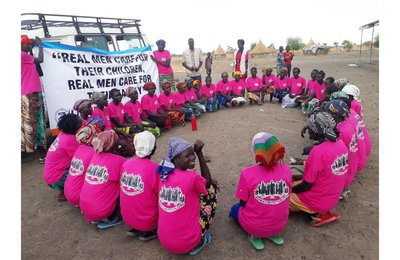 26 September 2012. Women attend a Workshop on the UN Security Council Resolution 1325 on Women, Peace and Security in Malha, North Darfur. Image credit: Sojoud Elgarrai - UNAMID
26 September 2012. Women attend a Workshop on the UN Security Council Resolution 1325 on Women, Peace and Security in Malha, North Darfur. Image credit: Sojoud Elgarrai - UNAMIDDo women hold the key ingredient to a peaceful society? Much is known about the victimisation of women through rape, trafficking, and early marriages, but much is yet to be discovered about how women can be empowered in conflict settings to bridge the gap toward peace. I recently conducted research analysing female peacemaking and found that women do hold significant capacity in the peace process. However, this significance is not always long-term, unless gender equality is institutionalised through the establishment of gender electoral quotas. Better understanding of how women can transform conflict and how creating space for them to do so will be a vital agenda for the UN and other concerned actors in the coming years.
In the creation of new development agendas seeking to specifically address the needs of women, the recommendation for female leadership in the peace process gathered greater force after success stories of women’s peace activism in countries like Liberia. A report by UN Women furthered this claim of calling for more female peacemakers by revealing that only 4% of peacemaking participants were women. Advocates for greater female representation declare that women are essential because they will bring a more comprehensive peace plan to the negotiating table by addressing societal needs rather than solely focusing on what will make the warring parties happy. However, a couple of key challenges exist in determining the extent to which women are able to aid the peace process.
After compiling a dataset of female participation by extracting gendered information from Uppsala’s Peace Agreements, I analysed the impact of women’s participation in peace processes on lasting peace. The results demonstrated that women do carry a positive and significant impact on peace as encouraging their participation increases the probability of violence ending within a year by 24%. However, restrictions do apply. For instance, including women in the peace process does not mean that adding a woman from outside the conflict, like from the UN or AU, will cause a more durable peace agreement to be implemented. Rather, it is local women from the conflict that are vital for creating a lasting peace agreement. This distinction is extremely important because it reveals that female presence does not necessarily provide the key to peace.
While quota policies requiring a certain number of women in peace processes can seemingly be a panacea creating stronger peace agreements, special attention needs to focus on the qualities of female participants that are truly pushing conflict towards a resolution. At this point, female representation has often been regarded as a requirement to check off the long list of peace agreement measures. This focus on quantity rather than quality of representation has been criticized by women’s groups, especially in policy development at the UN. Current cases like South Sudan illustrate how local women desperately want to become more involved in the peace process but are sidelined by the warring parties. How might South Sudan’s recent recurrence to violence be resolved if women are granted greater access to the negotiating table and a developing peace plan? Identifying these barriers will be critical for increasing the participation of women in peacemaking and therefore increasing the probability of lasting peace.
Based on these initial results, building local women’s capacity will be an important area of investment for the international community in order to encourage female leadership. Women have been called the necessary instruments of a sustainable peace. Only by creating more inclusive policies inviting the participation of women can the UN, state governments, and other interested institutions understand the vital role women carry. Building quality representation in local female leadership may be the key ingredient to a peaceful society as women are empowered as transformers of conflict.








